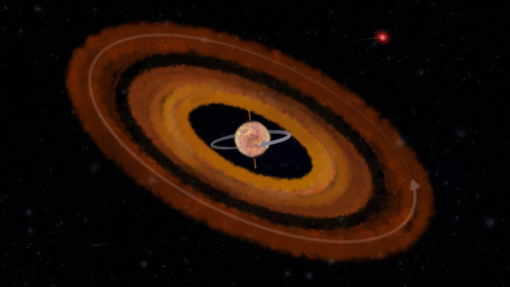Discovering new stars and planetary systems is always of great interest to us. But it becomes even more interesting when we find some rare or unique kind of systems.
New research has found a rare multi-planet system orbiting a star but the star doesn’t seem to have got the memo about which direction everyone is orbiting in.
Usually, it is assumed that planets and their stars rotate in the same direction. This is because they come from the same spinning molecular cloud.
But in the recently discovered planetary system, the star rotates in the opposite direction to its two planets. This system is located 897 light-years away from earth.
We know there are stars which spin differently from their planets, but this system is unique to itself.
The system named K2-290 is a three-star system with two planets orbiting its main star, K2-290 A.
One unusual thing about K2-290 A is its rotational axis is 124 degrees meaning it spins in the opposite direction to its planets.
Another unique thing about this system is that it’s spinning in the opposite direction to both its planets, as they are both orbiting on the same plane which makes explaining this directional difference a little harder.
In the case of our Solar System, the Sun rotates on an axis roughly tilted 6 degrees compared with the planets’ orbits, so we’re all going in the same direction.
Joshua Winn from Princeton University explained that this wasn’t the first case of a backwards planetary system. But this is a rare case where the team thinks they know what caused the drastic misalignment, and the explanation is different from what researchers have assumed might have happened in the other systems.
Going into theory we see that there is a wide assumption that a star and its protoplanetary disk (the spinning dense disk of gas and dust that forms around a young star where its planets form) start aligned with the star’s equator parallel to the disk plane.
One idea about this misalignment could be some kind of violent turbulence that occurred when the star was forming. Here it could be the disk which was affected. Another theory on this is that some neighbouring object could have the gravitational pull to throw planets out of whack, like a “hot Jupiter” that has the power to significantly alter the architecture of a planetary system.
Also, there’s a chance that this could be caused by a companion star, but there was none identified before.
The team proposed the idea that gravitational torque from a distant companion star exerting its force on the planetary disk caused the misalignment for K2-290 A, essentially tilting the disk.
K2-290 has three stars, so it’s possible one other is to blame for this misalignment. K2-290 B is a suitable candidate to be suspected for causing the misalignment, exerting enough gravitational force to move the disk.
Journal Reference:
Maria Hjorth, Simon Albrecht, Teruyuki Hirano, Joshua N. Winn, Rebekah I. Dawson, J. J. Zanazzi, Emil Knudstrup, and Bun’ei Sato A backward-spinning star with two coplanar planets PNAS February 23, 2021 118 (8) e2017418118; https://doi.org/10.1073/pnas.2017418118

